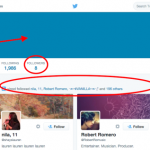Influencers vs. thought leaders and the rise of image analytics
Influencers and thought leaders aren’t one and the same. Contributor Will McInnes takes a look at how they’ve diverged and why it means marketers today need visual analytics to help measure their brand’s impact on the social web.

Let’s start with a question: Are influencers and thought leaders the same? I’ve found myself thinking about this quite a bit recently, and the easiest answer I can provide is “no.” They’re different — and this wasn’t always the case.
Whenever a new medium has emerged, certain people have always risen above the masses with uniquely suited methods and ideas to get the most impact for their efforts in that medium. As the prevalence of technology and social networks grew, we created equally uncreative names to call these new-media unicorns.
First were the early adopters, or “adapters” for those who really didn’t get it. Then, we saw the rise of the “mavens” and “gurus.” Currently, we are surrounded by the “thought leaders” and “influencers” — but the titles are no longer interchangeably appropriate.
The divergence of influencers and thought leaders
The split between these two — at one time synonymous — online personas developed with the rise and competition of new social sites. These smaller niche platforms didn’t attempt to supplant the massive social sites; rather, they simply tried to carve out their own submarket in the social media landscape — even if it was small.
This is when influencers and thought leaders quietly diverged from one another. And from this split came the need for visual analytics, even if marketers and consumer intelligence professionals didn’t realize it immediately.
Much like the actual wild, you can find thought leaders on sites like LinkedIn and Twitter. Thought leaders write blogs, contribute to forums and have columns on news sites. This is their habitat and where they are most comfortable and effective.
Conversely, influencers are more visual and attention-seeking. You’ll see them on platforms like Instagram and Snapchat. Thought leaders spread their message outward, whereas influencers invite you in so that you can bear witness to their lives. This is why influencers are prime resources for brand sponsorships and endorsements.
Most social platforms, even those favored by thought leaders, work toward being influencer-friendly. There are two reasons for this: Social content that includes an image or video is better at getting attention and engagement online. And secondly, advertising dollars flow to — and through — influencers.
A thought leader’s audience makes decisions. An influencer’s audience spends money. Thought leaders will get compensated for delivering keynotes, and influencers get paid to be present and relevant. A perfect example of this is Fyre Festival. Thousands of people flocked to an island because they saw pictures on carefully selected influencer social channels. With this type of power, and the corresponding money, image insights are a necessity.
Technology meets expectation
Marketers and researchers have discussed the practice of logo tracking for a while, but the technology is finally catching up to expectations. Unlike keyword and conversational tracking, logos and images may appear within social posts that make no mention of the brand, logo, sponsorship or endorsement.
Innumerable logos that appear in social images have no descriptor or mention of those logos/brands in the post’s text. This is a vulnerability that many marketers, social directors and researchers would like to remedy. Knowing that images provoke engagement, brands are potentially missing some of the most popular social posts that feature — even if only slightly — their likeness.
What’s more, image insights and visual analytics will help marketers provide attribution and value to endorsements and sponsors. Think of all the brands that pay celebrities and athletes to wear their apparel or push their product on social media.
What is image analytics and logo detection?
Image analysis won’t simply provide numbers for how many times a logo appears on social, but it will also offer context around the images and how they are used. This is accomplished in a two-step analytical process. The first step will gather all posts with images that feature the desired logo. Once those posts are accumulated, the next step will examine and analyze the accompanying text that’s featured in those posts.
The text will frame how an image is being used and identify the top topics and themes that appear alongside a picture. Marketers can expect that their endorsed influencers and sponsored events dominate the appearances of their logos. Any deviation away from this expectation is an insight into smarter ad spending.
Marketers, pay attention; this is important because…
… while skeptics might focus in on the irrelevant and question if visual analysis is pertinent when many posts are noise, true marketers and researchers know that those “irrelevant” posts actually add relevance, scale, and because of this, value. You can’t find the median amount of online posts that feature your logo without all posts.
Putting image insights into action
You want to ensure that your sponsorships and endorsements are driving the most posts that feature your logo. If you buy ad space in a stadium, how often is your logo seen in images from each match? How does your social conversation react each time you post a new image? The actions marketers can take from image analysis are numerous.
To come full circle, influencers and the social influencer movement spawned the need for visual analytics. And in turn, visual analytics provides the method to measure and find the social influencers that will push company logos the farthest on the social web.
It’s been a long time coming, but image analysis is the best way to track company ad spend on social, and it’s the next step in tying social to dollars and ROI. Armed with the information and data that visual analysis provides, marketers can measure influencer impact to a successful end.
Some opinions expressed in this article may be those of a guest author and not necessarily Marketing Land. Staff authors are listed here.
Marketing Land – Internet Marketing News, Strategies & Tips
(58)










